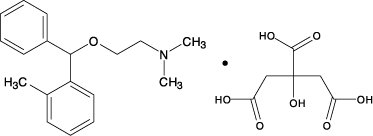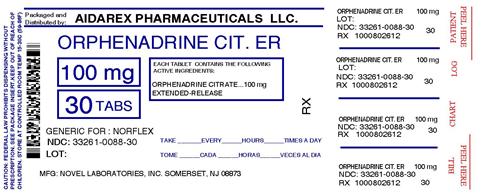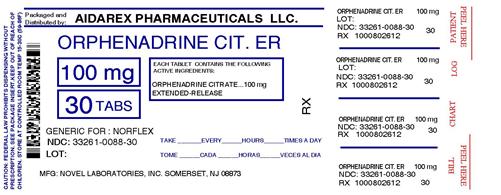Label: ORPHENADRINE CITRATE tablet, extended release
-
Contains inactivated NDC Code(s)
NDC Code(s): 33261-088-02, 33261-088-10, 33261-088-14, 33261-088-20, view more33261-088-28, 33261-088-30, 33261-088-60, 33261-088-84, 33261-088-90 - Packager: Aidarex Pharmaceuticals LLC
- This is a repackaged label.
- Source NDC Code(s): 43386-480
- Category: HUMAN PRESCRIPTION DRUG LABEL
Drug Label Information
Updated October 4, 2012
If you are a healthcare professional or from the pharmaceutical industry please visit this version.
- Download DRUG LABEL INFO: PDF XML
- Official Label (Printer Friendly)
-
DESCRIPTION
Orphenadrine citrate is the citrate salt of orphenadrine. It occurs as a white, crystalline powder having a bitter taste. It is practically odorless; sparingly soluble in water, slightly soluble in alcohol. The chemical name of orphenadrine citrate is (±)-N,N-Dimethyl-2-[(o-methyl-α-phenylbenzyl)oxy]ethylamine citrate (1:1) having molecular formula C18H23NO•C6H8O7 and molecular weight of 461.51. It has the following structural formula:

Each tablet for oral administration contains 100 mg orphenadrine citrate.
Each Orphenadrine citrate extended-release tablet contains the following inactive ingredients: hydroxypropyl methylcellulose, lactose monohydrate and magnesium stearate.
- CLINICAL PHARMACOLOGY
- INDICATIONS AND USAGE
-
CONTRAINDICATIONS
Orphenadrine citrate extended-release tablets are contraindicated in patients with glaucoma, pyloric or duodenal obstruction, stenosing peptic ulcers, prostatic hypertrophy or obstruction of the bladder neck, cardio-spasm (mega-esophagus) and myasthenia gravis.
Orphenadrine citrate tablets are contraindicated in patients who have demonstrated a previous hypersensitivity to the drug.
-
WARNINGS
Some patients may experience transient episodes of light-headedness, dizziness or syncope. Orphenadrine may impair the ability of the patient to engage in potentially hazardous activities such as operating machinery or driving a motor vehicle; ambulatory patients should therefore be cautioned accordingly.
-
PRECAUTIONS
Confusion, anxiety and tremors have been reported in few patients receiving propoxyphene and orphenadrine concomitantly. As these symptoms may be simply due to an additive effect, reduction of dosage and/or discontinuation of one or both agents is recommended in such cases.
Orphenadrine citrate should be used with caution in patients with tachycardia, cardiac decompensation, coronary insufficiency, cardiac arrhythmias.
Safety of continuous long-term therapy with orphenadrine has not been established. Therefore, if orphenadrine is prescribed for prolonged use, periodic monitoring of blood, urine and liver function values is recommended.
Pregnancy
Pregnancy Category C
Animal reproduction studies have not been conducted with orphenadrine. It is also not known whether orphenadrine can cause fetal harm when administered to a pregnant woman or can affect reproduction capacity. Orphenadrine should be given to a pregnant woman only if clearly needed.
-
ADVERSE REACTIONS
Adverse reactions of orphenadrine are mainly due to the mild anti-cholinergic action of orphenadrine, and are usually associated with higher dosage. Dryness of the mouth is usually the first adverse effect to appear. When the daily dose is increased, possible adverse effects include: tachycardia, palpitation, urinary hesitancy or retention, blurred vision, dilatation of pupils, increased ocular tension, weakness, nausea, vomiting, headache, dizziness, constipation, drowsiness, hypersensitivity reactions, pruritus, hallucinations, agitation, tremor, gastric irritation, and rarely urticaria and other dermatoses. Infrequently, an elderly patient may experience some degree of mental confusion. These adverse reactions can usually be eliminated by reduction in dosage. Very rare cases of aplastic anemia associated with the use of orphenadrine tablets have been reported. No causal relationship has been established.
- DRUG ABUSE AND DEPENDENCE
-
OVERDOSAGE
Orphenadrine is toxic when overdosed and typically induces anticholinergic effects. In a review of orphenadrine toxicity, the minimum lethal dose was found to be 2 to 3 grams for adults; however, the range of toxicity is variable and unpredictable. Treatment for orphenadrine overdose is evacuation of stomach contents (when necessary), charcoal at repeated doses, intensive monitoring, and appropriate supportive treatment of any emergent anticholinergic effects.
- DOSAGE AND ADMINISTRATION
-
HOW SUPPLIED
Orphenadrine citrate extended-release tablets 100 mg are round, white tablets, debossed GG 931 on one side and plain on the reverse side and are supplied as:
NDC 33261-088-07 in bottles of 7 tablets
NDC 33261-088-14 in bottles of 7 tablets
NDC 33261-088-20 in bottles of 7 tablets
NDC 33261-088-28 in bottles of 7 tablets
NDC 33261-088-30 in bottles of 7 tablets
NDC 33261-088-60 in bottles of 7 tablets
NDC 33261-088-84 in bottles of 7 tablets
NDC 33261-088-90 in bottles of 7 tablets
NDC 33261-088-120in bottles of 7 tablets
- 100 mg Label
-
INGREDIENTS AND APPEARANCE
ORPHENADRINE CITRATE
orphenadrine citrate tablet, extended releaseProduct Information Product Type HUMAN PRESCRIPTION DRUG Item Code (Source) NDC:33261-088(NDC:43386-480) Route of Administration ORAL Active Ingredient/Active Moiety Ingredient Name Basis of Strength Strength ORPHENADRINE CITRATE (UNII: X0A40N8I4S) (ORPHENADRINE - UNII:AL805O9OG9) ORPHENADRINE CITRATE 100 mg Inactive Ingredients Ingredient Name Strength HYPROMELLOSES (UNII: 3NXW29V3WO) LACTOSE MONOHYDRATE (UNII: EWQ57Q8I5X) MAGNESIUM STEARATE (UNII: 70097M6I30) Product Characteristics Color WHITE Score no score Shape ROUND Size 10mm Flavor Imprint Code GG931 Contains Packaging # Item Code Package Description Marketing Start Date Marketing End Date 1 NDC:33261-088-02 120 in 1 BOTTLE 2 NDC:33261-088-10 10 in 1 BOTTLE 3 NDC:33261-088-14 14 in 1 BOTTLE 4 NDC:33261-088-20 20 in 1 BOTTLE 5 NDC:33261-088-28 28 in 1 BOTTLE 6 NDC:33261-088-30 30 in 1 BOTTLE 7 NDC:33261-088-60 60 in 1 BOTTLE 8 NDC:33261-088-84 84 in 1 BOTTLE 9 NDC:33261-088-90 90 in 1 BOTTLE Marketing Information Marketing Category Application Number or Monograph Citation Marketing Start Date Marketing End Date ANDA ANDA040284 06/19/1998 Labeler - Aidarex Pharmaceuticals LLC (801503249)


